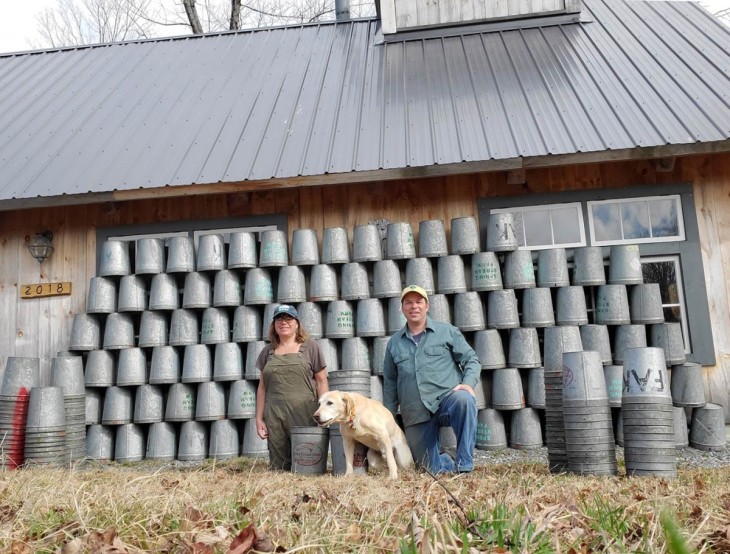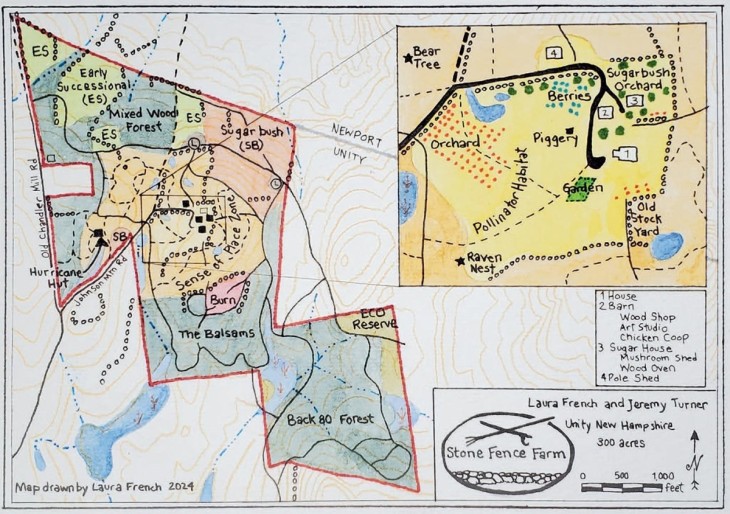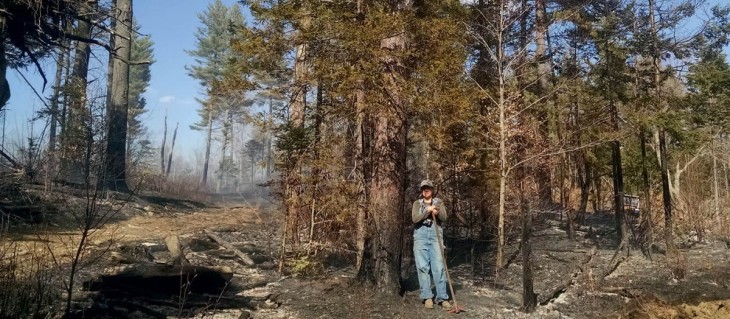
In 2004, foresters Laura French and Jeremy Turner connected at a Forest Stewards Guild meeting in Orono, Maine. Turner asked French if she’d like to join him on a hike in the woods.
“And that was the end,” she said.
“No,” he corrected with a wink, “that was the beginning.”
They married in spring 2009, soon after purchasing 240 acres of forestland in Unity, New Hampshire, which they named Stone Fence Farm. Since that time, through acquisitions of adjacent parcels, French and Turner have increased their total property size to 300 acres. The land abuts approximately 18 square miles of private working forest on its northern and eastern borders.
“If I were to describe it to another forester and leave out how I feel about it, I’d say the forest isn’t super exciting,” French said. “But the sense of place is magical. We love the idea of people making it here on this rugged hilltop farm; there’s not the good agricultural soil you find along the river.” Their predecessors, the Johnson family, subsisted on the hilltop for generations until the 1930s.
For the first few years of ownership, the couple, who work together at Meadowsend Consulting Company, spent weekends camping on the property, getting to know the land. “The first thing we did was pay attention,” Turner said. “We used a metal detector and found where the horse hovels and milking sheds had been.” By 2012, they had reclaimed the original 10-acre homestead and cropland opening, subsidizing the cost of this work by harvesting 60-year-old pine trees. That year, taking cues on location and orientation from the Johnsons’ landmarks, Turner and French broke ground on a post-and-beam barn and house.
The house is a monument to northern forests, constructed of 23 different species of native trees, including a different species for each of the 15 risers in the main staircase, all sourced from local timber harvests that Turner managed. A meticulously maintained logbook details each piece of wood’s origin, mill, and location in the house. A summer kitchen on the porch allows French to process the yield from her large garden. The pantry is full of homemade slaws, sauces, and syrups. There’s also a three-season sleeping porch and an outdoor shower. A single ground-mount solar panel powers the home, and Turner and French bake homemade pies and pizzas in a wood-fired brick oven built into the side of their sugarhouse.
In the forest beyond the apple orchard is Hurricane Hut, a small cabin constructed mainly from pallets. Here, neighbors gather for impromptu social events, as a disco ball spins above the woodstove. Stone Fence Farm’s resident ravens, Ross and Rose, caw frequently and swoop down from the trees to accept fresh chicken eggs. Wildflowers grow tall in the orchard, animated with pollinators. Shangri-La comes to mind.
As for the other 290 acres, 4 percent is open, 1 percent is wetlands, and the remaining 95 percent is forest. The forest, the couple estimates, is 15 percent hardwood, 10 percent softwood, and 70 percent mixed. The property has its gems: a healthy sugarbush, the headwaters to the Little Sugar River, vernal pools, and rich northern hardwood forest where maidenhair fern, blue cohosh, and Dutchman’s breeches grow in abundance. Still, French said, “It’s not a showcase property; it’s awesome, but average. What’s special about it is how well we know it and the management decisions we’re able to make as foresters.”
According to Turner, those decisions reflect his and French’s intent to maximize resiliency and diversity. “We leave the complex, old sites and eco reserves alone while looking for opportunities to create early successional habitat where it makes sense to do so. We need more early successional habitat in the region,” he said.
The pair has also undertaken numerous experiments on the property. One of these was a 10-acre burn that Turner and French planned with a wildfire team they knew in Vermont, with the goal of increasing diversity and promoting the regeneration of pine and early successional, mast-producing species, such as blueberry and fire cherry (also called pin cherry and bird cherry). “Our goal was to create awesome wildlife habitat, for bear and migratory birds especially,” said French.
The experience was thrilling. The fire burned hotter than expected and several of the remaining seed trees caught fire, their needles burning in spectacular fashion. Now, 10 years after the burn, the berries and pine are thriving, as are the oaks the couple planted after the burn. “It’s a wildlife magnet,” French said. “Bears love digging through the burned trees for protein-rich insects.”
Other experiments have been less successful. For example, 12 years ago, the couple planted 120 apple trees, each a different native variety. They planted the orchard to the west of the house. While they’ve lost only 10 percent of the trees, the remaining trees are somewhat anemic. “If we were to read the land with hindsight, knowing how little rain we get in the summer, we would have never planted these trees on the apex of this hill,” French said.
More recently, she was humbled when, failing to account for afternoon sun and airflow, her mushroom yard failed. “These are great lessons,” she said. “I may want something here, but the land might outright reject it.”
“It’s an incredible opportunity to practice, really practice, stewardship on our own land,” Turner added
The couple enjoy sharing their land and its lessons. This June, for the third time, they will host a birding workshop in collaboration with UNH Cooperative Extension and The Harris Center for Conservation Education. Participants will have the opportunity to camp on the property prior to the event, sharing dinner and breakfast before embarking on a day of birding. In 2022, participants and instructors identified 76 different bird species.
French and Turner have built 14 miles of trails for hiking, biking, skiing, and snowmobiling, and they invite friends and neighbors to recreate and hunt on the property. Undoubtedly, their favorite gatherings are during sugaring season when neighbors help collect sap. “We stay up all night, drinking whiskey, making maple syrup, dancing, and singing. Everyone, ages 2 to 80, is out walking around in the woods carrying buckets. It’s an amazing community event,” French said.
While unified in their long-term plans for the property, the pair don’t always agree upon specific plans immediately. “We have our own ideas and challenge each other,” French said. “We have lots of dinner-table discussions, but I think our disagreements and compromises make for the best management decisions.”
Last fall, after several such discussions, French and Turner decided to conduct their fourth timber sale on the property, this time along their driveway. For years, French had been reluctant to harvest the site. “I didn’t want to look at a timber sale – most people don’t – and I completely get that,” she said. But Turner reasoned the market for the trees, primarily 80-year-old pine and ash, was hot. A logger they know needed work, and it was an opportunity to enhance the site’s sugar maple stand.
Turner carefully selected the trees to hide the access point and landing and to protect views from the house. The 7-acre harvest grossed $2,000. “Ultimately, it was a good decision,” French said. “Owning and conserving land is expensive. Our goal isn’t to get rich, but sales like this will help us protect this place. People protect what they care about. That’s the story wherever you go. We live here, and this is our story.”



